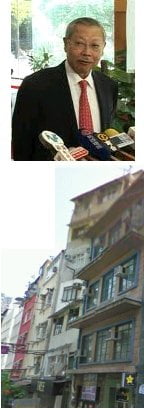First there was a fuss about indigenous villagers adding illegal extensions, such as an extra floor, to their houses in the New Territories; they were being treated far more leniently than Hong Kong’s post-19th Century interloping carpet-baggers in the urban areas. In essence, it was another backlash against the privileges Chief Executive Donald Tsang lavishes upon his client states-within-the-state, such as the aborigines’ Heung Yee Kuk mafia, the property developers’ cartel and his own grotesquely overpaid, overmanned and overweening civil service.
Then it got personal. Several legislators belonging to the Democratic Alliance for the Blah Blah of Hong Kong, our local public Communist Party front, were found to have illegal structures on their homes both north and south of the Mason-Dixon Line that is Boundary Street. Then, no doubt mindful of the ‘equal time’ guidelines, the press unearthed the illicit add-on at pan-democrat Leung Yiu-chung’s home. Then Undersecretary for the Environment Kitty Poon was found to have (a rather nice) one on her luxury villa.
Now, most embarrassing of all, Education Secretary Michael Suen has owned up to having a couple of unauthorized extensions jutting out of the side of his first-floor apartment in Happy Valley. Embarrassing because it was under his watch as Secretary for Housing, Planning and Lands that the Buildings Department sent him an order to remove the structures five years ago.
 With such a high-ranking figure caught in the act, some government detractors are calling for the hapless Suen to be publicly beheaded. But even now, the righteous outrage is curiously muted. And the reason for that is simple: nearly anyone who is anyone (ie, not living in public housing or a modern high-rise shoe-box) has, or has had, some sort of illegal modification built into their home. In many cases, people are barely aware of the alterations, which were done decades before by previous owners.
With such a high-ranking figure caught in the act, some government detractors are calling for the hapless Suen to be publicly beheaded. But even now, the righteous outrage is curiously muted. And the reason for that is simple: nearly anyone who is anyone (ie, not living in public housing or a modern high-rise shoe-box) has, or has had, some sort of illegal modification built into their home. In many cases, people are barely aware of the alterations, which were done decades before by previous owners.
Suen was not alone in ignoring the Buildings Department blitz on the phenomenon five years back. In my neighbourhood of Soho, the official letters were in nearly every low-rise mailbox. The majority of residents were given a month to remove the offending structure, typically a veranda absorbed into a living room, or face a fine and/or prison. The effect was to make many apartments maybe a third smaller, and thus uninhabitable for the families that had lived in them for decades. They sold and moved out, opening the way for new owners (often Westerners) to buy, convert to studios and lease out to Yuppie types at inflated rents. In practice, it was a clearance of the poor to make way for the rich.
A minority of residents got a different letter, like the one Suen got, giving them a month to fix the problem or face the insertion of a note into the property’s official record – thus alerting a future buyer to the existence of a forbidden structure. This was because the verandas annexed into living space did not overlook the street and threaten passers-by. These people were lucky and are still there. However, they live in fear of the day – maybe tomorrow, maybe in 10 years – when the bureaucrats finally and suddenly order the unlawful walls and roof demolished; it will be their eviction.
In theory, the background to all this is public safety; illegal structures have occasionally collapsed and killed people below or caused death by blocking fire escapes. However, many of them are probably structurally sound, and the hunt to eradicate them seems to be driven at least partly by official, and totally inflexible, vindictiveness. The government didn’t collect a premium on the land for the extra amount of roofed-in space; the owner didn’t go through the correct, impermeable, procedures to change a building; the dweller has the nerve to acquire a decent area when it is government policy to keep housing artificially scarce, expensive and tiny.
Suen, now 67 and on dialysis, was crassly hypocritical to oversee a policy of clamping down on illegal structures – forcing, in my street, families with live-in grandparents to up sticks and leave at a few weeks’ notice – while enjoying his own illegal washing-machine space. But what he really deserves to be flayed alive for is not questioning, indeed not giving a damn about, a brutal policy.


Erh, that cover version by Antar and the Sexbots of Moby Grape’s Hey Grandma is horrible.
I always thought that the Suenster, with his otter like visage, would have resided alongside a riverbank somewhere. That said, Suen is engaging in the time old HK strategy of ‘say nothing and they will forget next week’. It seems Suen knew his ex-department well. He does deserve a good kick up the khyber.
Just before the 1997 hand-over, in total and utter compliance with The Law, The Lands Department’s Sicherheitsdienst descended upon Hong Kong’s squatter villages in the early evening when, they knew, squatters would be at home having their evening meal.
To the shouts of “Raus! Raus! Raus!” squatters sans chickens, cats and their kittens, hamsters, pots, pans, clothing, photos, bedding and household paraphernalia, were forced to leave and leave everything behind.
Snakes then invaded and grew fat on the kitchen leftovers and pets. Those pets that survived were caught by another Government Sicherheitsdienst; and gassed. Or else tracked down from their squeals and cries, often muffled by plastic bags in which they were incarcerated by their former owners seeking a merciful death; then cleaned and fed and housed. In return, they gave me and mine years of good company.
MS should be hung drawn and above all quartered for simply being an irritant for too long. Clinker on the cortex?
Thanks for a fine piece, as usual going boldly where others fear to tread. But I do think you’re a bit harsh on the government. If they did nothing, sideways, upwards and perhaps even downwards extensions would be out of control in the remoter parts of the NT (I’ve already seen illegal structures on top of illegal structures).
Having said that, enforcement is very selective, relying essentially on complaints from individuals (one reason, I suspect, behind the current flurry of actions), rather than just going to look for themselves or examining aerial photographs.
I’m not sure that the government can always force removal, since I’ve not heard of many front doors being broken down. (And their attempt a few months ago to remove a shed resulted in being surrounded by scores of indigenous villagers.) They can, as you say, insert a note in the deeds; I read somewhere (SCMP?) that this makes it impossible, rather than more difficult, to sell the property.
As you have shown again and again, the government has lost much legitimacy through its refusal to stand up for HK and through its non-democratic basis, so it’s not surprising that its edicts are circumvented. It has now lost a little bit more of its moral legitimacy.